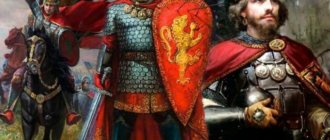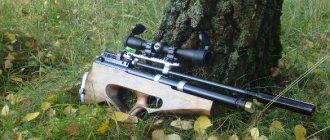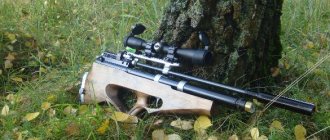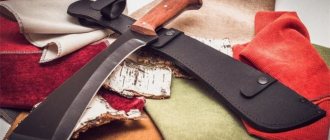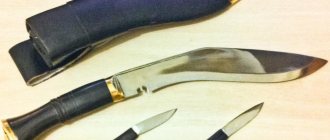“Don't expose me unnecessarily. Do not sheathe me without honor” is the motto on the blade of a sword from Toledo, Spain.
European one-handed sword (device) Guard Pommel Hilt Blade Blade
The European sword consists of two main parts:
The structure of a European one-handed sword
The image shows: a European one-handed sword, Oakeshott type X and a Katzbalger - a short one-handed sword of the Renaissance
1) Handle , which in turn consists of a pommel (apple), handle, guard (cross), shank
2) Blade blade , which in turn consists of a fuller, a blade and a tip.
Blade
The blade has many interpretations united by a common message. A blade is: 1) the cutting part of a bladed weapon or knife (literary dictionary, Ushakov); 2) the cutting and piercing part of edged weapons (literary dictionary, Ozhegov); 3) strip, generally the steel part of a cold, sharp weapon (except for a bayonet) and a knife (literary dictionary, Dahl).
And yet, what concept should be the key? It would be correct to turn to the legal concept of the word blade - an extended metal warhead of a bladed weapon with an edge, with an edge and one or two blades, or with two blades, which is part of a strip, this definition is enshrined in GOST R 51215 98. This is the generally accepted understanding of the word - blade .
However, we will also derive a specific concept of blade, associated with the reality of the Zbroevy falvarak workshop, the blade of the ZF workshop is an extended metal warhead of the product, with an edge, with an edge and one or two blades, or with two blades, which is part of a strip, externally and structurally similar to edged weapons.
The main feature: the master craftsmen of the Polar Division do not make edged weapons, but make mass-sized copies).
1) Let's take a closer look at the individual parts of the hilt:
Edged weapons today
Such blades today adorn not only museums, but also private collections. Every self-respecting hunter, at the first financial opportunity, will purchase the best and most expensive weapon, and his male children and grandchildren will try to replenish the collection not with reliable exhibits, but with beautiful ones. Collections can be located on the wall or occupy entire rooms. You can hang a carpet on the wall, and crossed swords or sabers on it. Guns are becoming toys for grown men. What is the garda today? Decoration of a fashionable toy for men.
Finial (apple):
Pommel - this element of the sword is designed to balance it, only a balanced sword is suitable for skillful fencing with it; in different schools of weaponry, the balance may be different. However, it is considered a generally accepted way to measure the balance of a sword - this is measured using the fingers of the hand, as a rule, a good balance for a European blade should be four fingers from the sword guard.
How to establish balance using your fingers?
We take the blade of the sword and look at its balance, for this we place the blade on one finger of the hand, removing or bringing the finger closer to the guard, we find the point when neither side outweighs the other. This is where the balance will be.
In addition, the pommel serves to rest the hand, this is especially important because during a fight the sword begins to slide until the hand rests on the pommel.
Notes[edit]
- Some palliative methods of obtaining the semblance of a blade - for example, sticking a stick into a row with fragments of obsidian or shark teeth - were also known to peoples who did not know bronze, but the result was obtained... with varying degrees of success. Some peoples also created sword-like flat clubs from ironwood, and “glaives” and “axes” were also made from the same wood.
- Almost impossible, in Greece, before the Trojan War, almost meter-long narrow piercing bronze swords, known as “Mycenaean rapiers,” were successfully used, and in China, almost simultaneously with the advent of steel, meter-long bronze swords made of alloyed bronze appeared, which cost so fabulously that they could afford it VIPs only.
Sword hilt:
Sword hilt - designed to hold the sword with the hand. The handle of the sword should fit comfortably in your hand, because an inconvenient handle will affect your fencing capabilities. Therefore, when buying a sword, you need to pay attention to how well the hilt fits your hand. At the moment, it is possible to confidently identify and classify swords by the number of grips on the handle with the hand. So at the moment swords are divided into:
– One-handed swords – One-and-a-half-handed swords – Two-handed swords
Comparative graphics: scale of bladed weapons from one-handed to two-handed
Typically, one-handed swords mean light European blades designed for quick fencing with one hand; such swords are usually light and have a blade from 50 to 80 cm and are a classic weapon for both participants in the role-playing movement and participants in the medieval reconstruction movement.
Oakeshott type X one-handed sword
By swords with a one-and-a-half grip (bastards) , we mean swords that can be held with either one hand or two. Depending on the situation, a fencer can fence with one hand and hold the shield with the other, but if necessary, he can take such a sword in two hands and fence with it, holding it with both hands, thereby reducing the fatigue of one hand. By medieval standards, a one-and-a-half-handed sword was chest-high to the owner. This length allows you to hold an enemy who has a one-handed sword at a greater distance and thus be able to strike from a greater distance. Nowadays, it is not uncommon for a bastard sword to become a weapon for a beginner who is just starting out on the path to understanding the basics of fencing. This type of sword is widespread both among role-players and medieval reenactors.
Oakeshott Type XVIa one-and-a-half-handed sword
Two-handed swords , as usual, are large, heavy knightly swords of the slasher type; fencing with such a sword requires significant physical strength and skill. This sword is designed to be held and fencing with two hands; thanks to its blade length of more than 110 cm, it is a long-range weapon. By medieval standards, the two-handed sword was up to the owner's chin. In general, two-handed swords are very dangerous in fencing, as they often cause significant injuries. At the moment, swords of this type are quite rare in the role-playing and reenactment movement. In the role-playing movement, this sword has gained relevance due to the fact that such swords, thanks to the rules of combat interaction in a role-playing game, cause more damage to the enemy than a one-handed or one-and-a-half-handed sword. But their production requires a significant amount and high quality of material, coupled with high skills of the craftsman - therefore, two-handed swords are much less common than one-and-a-half-handed or two-handed swords. In addition, such swords often become artifacts or some other symbol of magic in role-playing games. In the movement of medieval reenactors, the double-dealer is not very common due to the fact that to work with both hands during fights or buhurts, a fencer needs a very high-quality protective armor complex.
Two-handed sword, XIX Oakeshott type
The indicated classification and sizes of swords are relative and taken from our experience and the experience of other masters. So, for example, in Japan, a sword 50 cm long, like a wakizashi, or a sword 70 cm long, like a katana, have a two-handed grip. With the same success, the European bastard can be with a two-handed grip.
Like the pommel, the handle is part of the blade balancing system. This statement especially applies to swords made using the “welded glass” system, and then using the “steel pipe” and “welded steel plates” system. For historical swords this is less relevant, because the hilt of such swords is made of wood, although, for example, the ninja sword, shinobi-ken, has an all-metal hilt.
Description and typology
The hilt is the part of the sword that is attached to the blade and is designed to be held in the hand. This detail often determines the ability of a bladed weapon to hit an enemy.
The hilt, guard and hilt are the three different components of swords. The first is attached next to the blade, the second - at the tip of the weapon.
The hilt and guard were often used during battle to deliver blunt blows to the enemy. Therefore, blacksmiths paid increased attention to the creation of these components.
In modern literature, the classification of swords introduced by Ewart Oakeshott has been adopted. This typology is also used to distinguish types of handles:
- Sandwich. A handle cut from two halves and attached to the sides of the shank. Sandwiches were used in weapon making until the 12th century. Cuttings of this type are distinguished by a flat or oval cross-section and cone-shaped shape.
- Tubular. Such handles were made for long blades, since the latter required a tighter and tighter grip and better balancing. The handle for such a weapon was first made in the form of a solid structure, in which a hole was then drilled for the shank.
Oakshot identified 8 groups of swords. A similar classification is often applied to cuttings. Moreover, the latter, according to the general typology, are divided into two indicated types.
The shape of the handles varies as well as the blades.
The handles were made of dense wood, horns or bones, which were then wrapped in leather, cloth or parchment.
Guards (crosspieces, also called “armchair”)
Sword guards
Sword guard - this element of the sword hilt is designed to protect the hand during fencing, from blows from the enemy’s sword blade. Different countries and peoples have created guards of different shapes. In addition, the guard performs the function of balancing the sword.
Shank
may or may not be present on the guard. It is believed that the presence of a tang on the sword allows the blade to better absorb impact energy and thereby protect the blade from vibration and loosening in the hilt.
2) Let's take a closer look at the individual parts of the blade:
Dawn
Legendary Dawn
The Dawn is a Daedric Artifact, which makes it super cool and super rare. By completing the quest "The Dawn" and swearing allegiance to Prince Meridia, you will master his power.
Sword characteristics
- Base Damage: 12
- Weight: 10
- Base value: 740
- Additional Effects: Burns for 10 points and when killing an undead enemy there is a chance it will explode.
- Class: one hand
- Upgrade Ebony Ingot
- Perk: No
What makes Dawnbreaker awesome
- He blows up the undead, what more do you need?
- It causes burns with every swing
How to get Dawn
- Receive Meridia's Beacon
- Take it to the Shrine of Meridia
- Complete the Dawn quest.
Skyrim - How to get the Dawning - Dawning Daedric Weapons Guide
wind shear
Wind shear
Sword characteristics
- Base Damage: 11
- Weight: 10
- Base value: 40
- Additional Effects: Hits with this weapon have a chance to knock enemies down.
- Class: one-handed
- Upgrade steel ingot
- Skill: Blacksmithing
What makes Windshear so cool
- When paired with a shield, the combo is unstoppable
How to get Windshear
- Complete the Dark Brotherhood quest "Hail Sithis."
Skyrim: How to get Windshears
